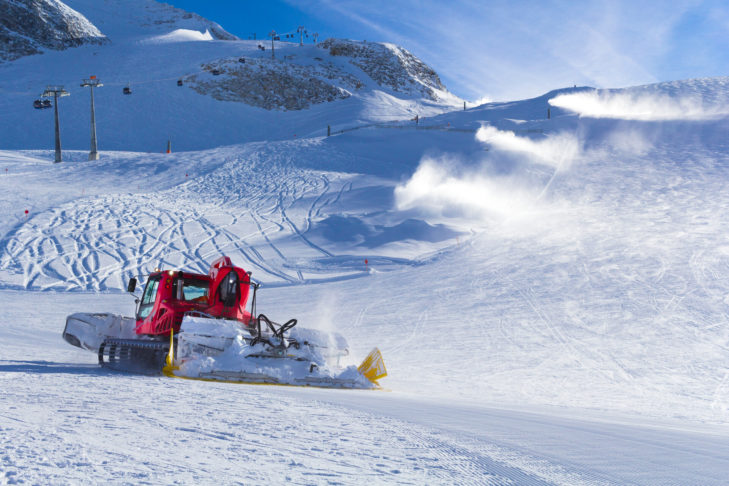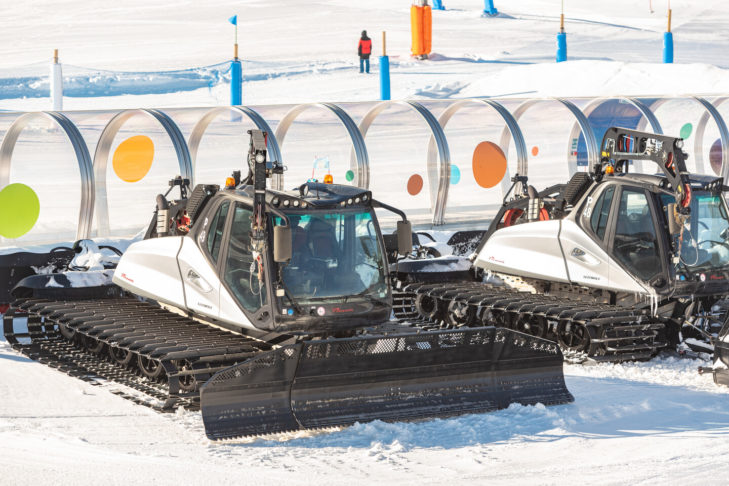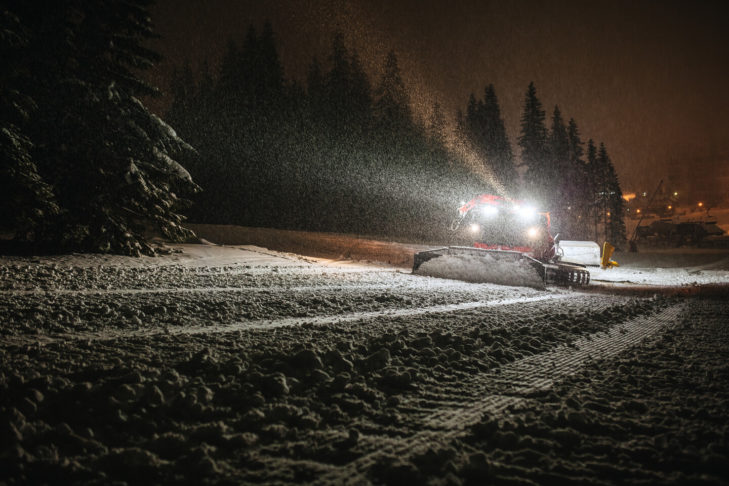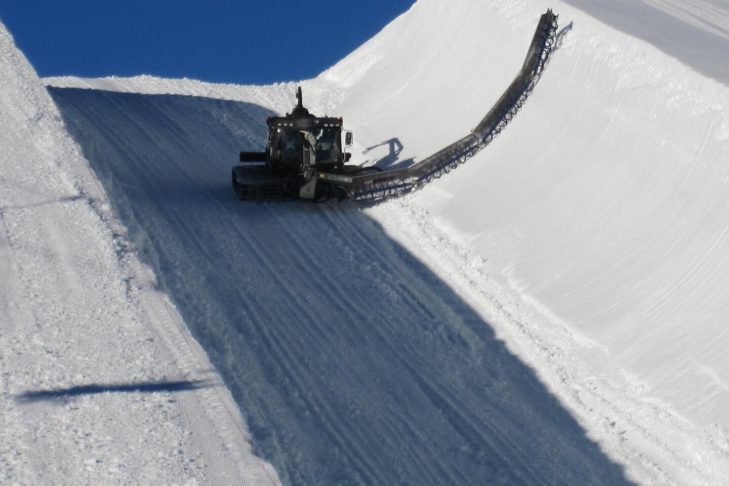Gentle carving turns on perfectly groomed pistes: this or something similar is every skier’s dream come true. Snow groomer drivers have their fair share of responsibility for the ideal snow cover in the ski area. And SnowTrex explains how they manage to ensure that thousands of winter sports enthusiasts can enjoy the perfect piste experience on snow-covered slopes day after day using both equipment that weighs several tonnes and a good amount of sensitivity.
The history of the snow groomers
The founding father of snow groomers or snowcats, as winter sports enthusiasts now know them from the ski resorts, was a Canadian. Armand Bombardier’s name alone is still world-famous in the 21st century. The company that bears his name still produces vehicles, trains and aeroplanes to this day. And it was Bombardier who first designed a snowmobile in 1922 and then launched the first tracked vehicle on the market in 1935. In the harsh Canadian winter, the SnowCoach was used to transport people and materials. The vehicle was equipped with steerable runners at the front, while a chain drive was used on the rear axle.
As skiing became increasingly popular in the 1950s, ski resorts also had to adapt and prepare their pistes accordingly for winter sports enthusiasts. Initially, the snow on the slopes was compressed using hand-pulled rollers. To make this physically demanding work easier, tracked vehicles with a mounted piste roller were developed by Bombardier and others in North America during this time. In Europe, the Canadians worked together with an Austrian company from Graz in the 1960s. Shortly afterwards, the BS 01 model and thus the first European snow groomer was presented as a joint project.
In the 1970s, the demand from ski resorts for snow groomers was so high that almost 30 manufacturers sold their models in Europe. However, many of these smaller companies have since been bought up by larger competitors. Today, the market leaders in the snow groomer segment are the German company Kässbohrer Geländefahrzeug AG with its well-known “Pistenbully” brand and Prinoth AG from Sterzing in South Tyrol.
A snow groomer driver’s working equipment
Snow groomer drivers have to be very sensitive and precise in their work in order to leave behind a perfectly groomed piste. In contrast to this, however, is their massive working equipment. After all, snow groomers can weigh up to 14 tonnes. They are powered by powerful diesel engines which, depending on the model, can deliver over 500 hp. To tame this power, however, drivers are less and less likely to reach for a traditional steering wheel. Some large vehicles are now equipped with joysticks in the driver’s cab. And that’s not the only thing that’s really futuristic. The many different functions of a snow groomer are operated via displays and dozens of buttons. With so much advanced technology, it goes without saying that it also costs a lot. In some cases, the ski resorts have to pay up to 350,000 euros for a snow groomer.
Despite these impressive figures, the top speed of the heavy tracked vehicles when grooming slopes is anything but fast. Due to their heavy weight and the steep slopes that snow groomer drivers have to negotiate in the ski resorts, they only travel at 10 to 15 km/h there. Fuel consumption, on the other hand, is 30 to 40 litres of winter diesel per hour. The fuel differs from normal diesel in that special chemicals have been added to it to prevent it from flocculating (clumping) or even freezing in the tank in winter temperatures on the mountain.
Impressive performance on the mountain and curious names
In order to do their job to the best of their ability, snow groomer drivers must be able to drive on any slope with their work equipment. No matter how steep the gradient. Anchor points are therefore installed at the start of the steepest slopes. The steel cables, which are up to 1,500 metres long and rolled up on the winches of the tracked vehicles, can then be fixed there. They are one of the most important safety systems on board, as they serve as a climbing aid to prevent slipping. In total, these cable winches have a pulling force of almost 4.5 tonnes and enable modern snow groomers to drive up slopes with gradients of up to 45 degrees or 100%. For comparison: the steepest piste in the Alpine Skiing World Cup, the Kandahar in Garmisch-Partenkirchen, has a gradient of 92% at its peak.
By the way: When winter sports enthusiasts talk about snow groomers, snowcats and “Pistenbullys”, they always mean the same thing. The term “snowcat” is commonly used in North America when talking about the heavy tracked caterpillar vehicles used to prepare pistes. In addition, the terms snow groomer and piste basher are also used. “Pistenbully”, on the other hand, is actually a brand name used predominantly amongst Germans. The German manufacturer Kässbohrer has given this official name to its snow groomers. For example, the “PistenBully 400” or “PistenBully 600” models are used in some ski resorts. The nickname for the tracked vehicles was simply adopted, similar to the way a vacuum is commonly referred to as a Hoover.
How many snow groomers are used in a ski resort ultimately depends largely on the size of the snow area. For example, 7 snow groomers are used every day on the 112 kilometres of pistes in Obergurgl in Ötztal. In Serfaus-Fiss-Ladis (198 kilometres of pistes), on the other hand, the fleet already includes 21 heavy tracked vehicles.
Snow groomer manufacturers and ski resorts focus on sustainability
In order to make the operation of snow groomers sustainable, some ski resorts, such as in Kleinwalsertal, are currently testing the switch to biofuels, for example based on plant waste. The lifts there hope to reduce the CO₂ emissions of the heavy tracked vehicles by up to 90%. The two market leaders, Pinroth and Kässbohrer, go even further when it comes to engine concepts. The German manufacturer already offers its top-of-the-range model, the “Pistenbully 600 E “, with a diesel-electric engine. Overall, this reduces the CO₂ emissions of the hybrid by 20% per vehicle. However, both companies have now also equipped one of their smaller models with purely electric drives (around 250 hp) and are now using them in some ski resorts for test purposes.
The following clip shows how the tests with the electric snow groomer from Germany went and what the participants have to say about the results:
Please also note that by using our services and integrating the YouTube API Services, the YouTube Terms of Service and the YouTube API Services Terms apply and your use of our website is deemed to be acceptance of these terms.
In 2020, the snow groomer experts from South Tyrol also went in a different direction in terms of sustainability and presented a prototype with a hydrogen fuel cell (544 hp). In 2022, the concept was further developed when the “LEITWOLF h2MOTION” was also presented with a hydrogen combustion engine (460 hp).
Snow groomer driver: A job for night owls
If you want to become a snow groomer driver, you shouldn’t be an early riser, as the job is more for night owls. After all, the heavy tracked vehicles are only taken out of the garage when skiers and snowboarders have just taken the last gondolas down into the valley or are already enjoying the first cold drinks at après-ski. This means that the shift for snow groomer drivers usually starts at around 16:00. They first check the condition of their vehicles in the vehicle depots of the ski resorts. This includes testing all the important functions and controls, checking the chain drive for damage, measuring the oil level and, of course, refuelling. Just under an hour is set aside for this procedure before they hit the slopes at around 17:00, shortly after the piste closes.
Who has to groom which slopes is set out in advance in the day’s work schedule. In order to optimally distribute the snow on the allocated slopes, snow groomer drivers in some ski resorts are now supported by GPS systems. They display the snow depths in real time on a screen in the cockpit and show the driver where he may still need to make adjustments. In order to leave ski guests with perfectly groomed pistes the next day, the work has to be done very precisely and therefore takes a lot of time. For snow groomer drivers, this means that they usually only finish work between 23:00 and 01:00.
In one very special case, however, a snow groomer driver’s shift may even start at 04:00 in the morning. This is when snow has fallen in the dark. Because the first lifts open between 08:00 and 09:00, they have just under 4 hours to prepare the slopes for the paying skiers. To do this, the fresh snow is either compacted directly on the slopes or pushed to the edge of the slopes.
One driving licence and a passion for winter, please!
First things first: being a snow groomer driver is not a job that can be attained through a standard apprenticeship. People who do this job always start out as normal employees at the mountain lift. Anyone who has ambitions to drive the heavy tracked vehicles on the piste every day in winter can first inform their employer, i.e. the ski resort operator. And in the event that the piste maintenance teams need staff support, prospective snow groomer drivers first receive a comprehensive introduction from an experienced colleague. He first familiarises the newcomers intensively with their work equipment before they work shifts preparing the slopes together. The driver, who has been in the job for many years, explains what needs to be observed on the terrain in the ski area and how the snow groomers can be manoeuvred safely over the slopes. Their knowledge in the field of piste preparation is also regularly updated through further and advanced training.
The following video shows what a snow groomer driver’s day-to-day work looks like:
Please also note that by using our services and integrating the YouTube API Services, the YouTube Terms of Service and the YouTube API Services Terms apply and your use of our website is deemed to be acceptance of these terms.
In addition to a passion for winter, prospective snow groomer drivers should definitely have a driving licence. In Swiss ski resorts, this job also requires a truck driver’s licence. Technical know-how and manual skills are also required for handling heavy equipment such as a snow groomer – at least the basics. You should also have a knowledge of physics and an interest in meteorology in order to be able to guarantee optimum piste preparation even in the most varied snow conditions.
What a snow groomer driver earns
Overall, while snow groomer driver may be a very seasonal job, in winter it is a full-time job with a 40-hour week, which is also carried out on public holidays and at weekends. After all, that’s when the ski resorts are open. On average, you can earn over 2,100 euros gross per month. The monthly salary can also be increased through further qualifications.
Snow groomer drivers are artists in the snow
In their daily work in the ski area, the main task for snow groomer drivers is of course the perfect preparation of the secured slopes. But they also have other important responsibilities. And some specialists even become real “artists” in the snow. The heavy tracked vehicles are used to shape obstacles and kickers in fun parks or to create half-pipes for ski and snowboard freestylers. Additional “tools” such as metre-long, curved special snow tillers can be installed on the snow groomers to precisely carve the profiles of these spectacular obstacles, such as the world-famous superpipe in Laax, into the slope.
Snow groomers are also used in most ski resorts to open up new pistes or to pave and maintain winter hiking trails. But that’s not all. Because of their size, snow groomers are virtually predestined for transporting heavy loads. It is also their job to supply the huts and mountain restaurants in the respective ski area with tonnes of food and thousands of litres of drinks every year, as well as to transport other technical equipment or building materials from A to B on the mountain. In short, everything that the infrastructure there needs.
However, for all their creative and important activities, snow groomer drivers must also have a healthy understanding of the dangers of their job. On the one hand, they move special equipment weighing several tonnes every day, which may only be moved very carefully at certain points in the ski area or must even be specially secured there. In order to avoid accidents, such as with ski tourers, who are often not always immediately recognisable in snow-covered terrain and are therefore easy to overlook, snow groomer drivers must always maintain absolute concentration in the driver’s cab. They must also always keep an eye on the weather for their own safety. In snowfall and fog, drivers may lose their bearings due to poor visibility, especially in the dark. As a result, they can quickly manoeuvre themselves unintentionally into an avalanche danger zone or onto steep slopes in difficult terrain.
FAQ’s on snow groomer drivers
What do snow groomer drivers do?
The job of a snow groomer driver is varied. They are mainly responsible for grooming the marked pistes in the ski area. They maintain the winter hiking trails with their heavy equipment, open up new pistes and create snow obstacles in fun parks and halfpipes. They also transport tonnes of food and drinks to huts and mountain restaurants, as well as building materials and other technical equipment for the infrastructure in the ski area.
How long have snow groomers been around?
The Canadian Armand Bombardier, whose company still manufactures vehicles, trains and aeroplanes today, is considered the forefather of snow groomers. in 1922, he initially designed a snowmobile before presenting the first heavy tracked vehicle that could also be used on snow in 1935. In the 1950s, Bombardier combined the vehicle concept with a snow groomer, creating the world’s first snow groomer.
How much does a snow groomer cost?
In the 21st century, snow groomers are full of advanced technology. The largest snow groomers weigh up to 14 tonnes and are powered by engines with 500 hp and more. This means that the largest snow groomer models cost up to 350,000 euros each.
What job requirements must snow groomer drivers fulfil?
Being a snow groomer driver is not a job that can be attained through a standard apprenticeship. Employees of ski resort operators or mountain railways who want to supplement the piste maintenance teams are always trained by experienced colleagues. Anyone who wants to become a snow groomer driver must have a driving licence. In Switzerland, a licence to drive a truck is also required. It is also an advantage if prospective snow groomer drivers have technical know-how, manual skills and an interest in physics and meteorology.
How many snow groomers are needed per ski resort?
The number of snow groomers differs from ski resort to ski resort. The size of the fleet ultimately depends largely on the size of the ski resort. In Obergurgl (122 kilometres of pistes), for example, there are 7 snow groomers in use every day, while in Serfaus-Fiss-Ladis (198 kilometres of pistes) there are 21.






